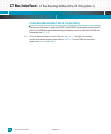
10006024-04 Katana
®
752i User’s Manual
13-1
Section 13
CT Bus Interface
The Katana
®
752i supports an optional computer telephony (CT) bus interface that routes
various signals from the CompactPCI J4 backplane connector to the PCI Telecom Mezza-
nine Card (PTMC) expansion sites. The Katana
®
752i complies with Configuration 2 of the
PCI Telecom Mezzanine/Carrier Card Specification, PICMG 2.15.
Note: The standard Katana
®
752i configuration does not support any of the CT bus interface options.
PICMG 2.15 CONFIGURATION 2
PTMC mezzanine and carrier cards supporting PICMG 2.15 Configuration 2 are identified as
PT2MC and PT2CC. This configuration includes a Time Division Multiplexed (TDM) inter-
face, a Reduced Media Independent Interface (RMII), and a TTL serial port.
There are several compatibility types between combinations of a carrier card and a mezza-
nine card. Although PTMC and PTCC are mechanically compatible with each other, the PMC
mezzanine or carrier cards electrical compatibility is partially determined via PCI Telecom
Identifiers (PTIDs) and enable (PTENB*) signals. The Katana
®
752i compares the PTID to
configurations that it supports and activates PTENB* after determining compatibility is
acceptable. At power-up, PTENB* is inactive and will activate once electrical compatibility
is determined via the PTIDs.
Another method to determine compatibility is interoperabilty. There are three interopera-
bilty categories for combining mezzanine and carrier cards, per PICMG 2.15:
• Fully Interoperable Combination (FIC)
FIC indicates combinations that do not limit functionality and are never a destructive com-
bination. The Emerson Katana
®
752i (PT2CC) and
PM/3Gv (or other PT2MCs) are a fully interoperable combination.
• Non-Destructive Combination (NDC)
NDC indicates combinations that are not intended to interoperate, but will not cause dam-
age to either the carrier or mezzanine card. For example, combining a PT2MC and a PT4CC
is an NDC.


















